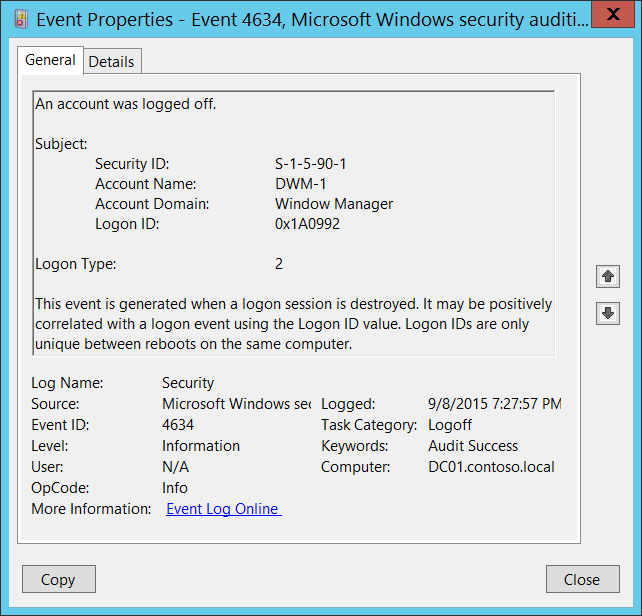4634(S): An account was logged off.

Subcategory: Audit Logoff
Event Description:
This event shows that logon session was terminated and no longer exists.
The main difference between “4647: User initiated logoff.” and 4634 event is that 4647 event is generated when logoff procedure was initiated by specific account using logoff function, and 4634 event shows that session was terminated and no longer exists.
4647 is more typical for Interactive and RemoteInteractive logon types when user was logged off using standard methods. You will typically see both 4647 and 4634 events when logoff procedure was initiated by user.
It may be positively correlated with a “4624: An account was successfully logged on.” event using the Logon ID value. Logon IDs are only unique between reboots on the same computer.
Note For recommendations, see Security Monitoring Recommendations for this event.
Event XML:
- <Event xmlns="http://schemas.microsoft.com/win/2004/08/events/event">
- <System>
<Provider Name="Microsoft-Windows-Security-Auditing" Guid="{54849625-5478-4994-A5BA-3E3B0328C30D}" />
<EventID>4634</EventID>
<Version>0</Version>
<Level>0</Level>
<Task>12545</Task>
<Opcode>0</Opcode>
<Keywords>0x8020000000000000</Keywords>
<TimeCreated SystemTime="2015-09-09T02:27:57.877205900Z" />
<EventRecordID>230019</EventRecordID>
<Correlation />
<Execution ProcessID="516" ThreadID="832" />
<Channel>Security</Channel>
<Computer>DC01.contoso.local</Computer>
<Security />
</System>
- <EventData>
<Data Name="TargetUserSid">S-1-5-90-1</Data>
<Data Name="TargetUserName">DWM-1</Data>
<Data Name="TargetDomainName">Window Manager</Data>
<Data Name="TargetLogonId">0x1a0992</Data>
<Data Name="LogonType">2</Data>
</EventData>
</Event>
Required Server Roles: None.
Minimum OS Version: Windows Server 2008, Windows Vista.
Event Versions: 0.
Field Descriptions:
Subject:
- Security ID [Type = SID]: SID of account that was logged off. Event Viewer automatically tries to resolve SIDs and show the account name. If the SID cannot be resolved, you will see the source data in the event.
Note A security identifier (SID) is a unique value of variable length used to identify a trustee (security principal). Each account has a unique SID that is issued by an authority, such as an Active Directory domain controller, and stored in a security database. Each time a user logs on, the system retrieves the SID for that user from the database and places it in the access token for that user. The system uses the SID in the access token to identify the user in all subsequent interactions with Windows security. When a SID has been used as the unique identifier for a user or group, it cannot ever be used again to identify another user or group. For more information about SIDs, see Security identifiers.
Account Name [Type = UnicodeString]: the name of the account that was logged off.
Account Domain [Type = UnicodeString]: subject’s domain or computer name. Formats vary, and include the following:
Domain NETBIOS name example: CONTOSO
Lowercase full domain name: contoso.local
Uppercase full domain name: CONTOSO.LOCAL
For some well-known security principals, such as LOCAL SERVICE or ANONYMOUS LOGON, the value of this field is “NT AUTHORITY”.
For local user accounts, this field will contain the name of the computer or device that this account belongs to, for example: “Win81”.
Logon ID [Type = HexInt64]: hexadecimal value that can help you correlate this event with recent events that might contain the same Logon ID, for example, “4624: An account was successfully logged on.”
Logon Type [Type = UInt32]: the type of logon which was used. The table below contains the list of possible values for this field:
| Logon Type | Logon Title | Description |
|---|---|---|
| 2 | Interactive | A user logged on to this computer. |
| 3 | Network | A user or computer logged on to this computer from the network. |
| 4 | Batch | Batch logon type is used by batch servers, where processes may be executing on behalf of a user without their direct intervention. |
| 5 | Service | A service was started by the Service Control Manager. |
| 7 | Unlock | This workstation was unlocked. |
| 8 | NetworkCleartext | A user logged on to this computer from the network. The user's password was passed to the authentication package in its unhashed form. The built-in authentication packages all hash credentials before sending them across the network. The credentials do not traverse the network in plaintext (also called cleartext). |
| 9 | NewCredentials | A caller cloned its current token and specified new credentials for outbound connections. The new logon session has the same local identity, but uses different credentials for other network connections. |
| 10 | RemoteInteractive | A user logged on to this computer remotely using Terminal Services or Remote Desktop. |
| 11 | CachedInteractive | A user logged on to this computer with network credentials that were stored locally on the computer. The domain controller was not contacted to verify the credentials. |
Security Monitoring Recommendations
For 4634(S): An account was logged off.
Important For this event, also see Appendix A: Security monitoring recommendations for many audit events.
- If a particular Logon Type should not be used by a particular account (for example if Logon Type 4-Batch or 5-Service is used by a member of a domain administrative group), monitor this event for such actions.